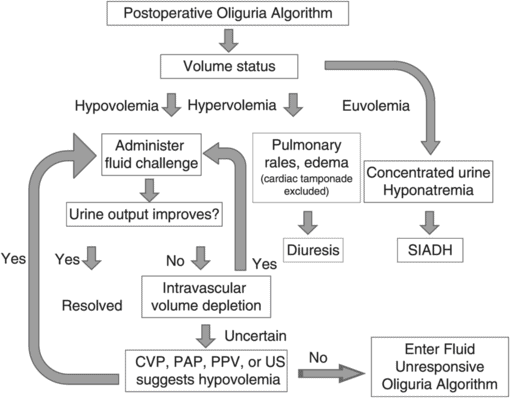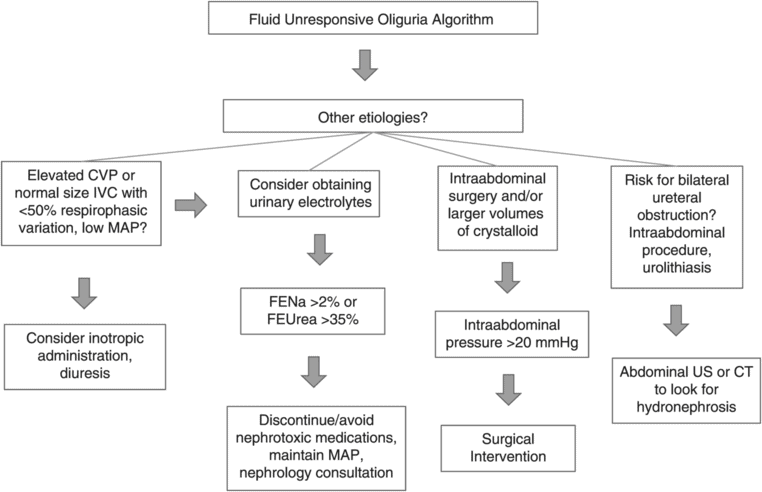Initial evaluation of postoperative oliguria.

Postoperative oliguria diagnosis and management. CVP, central venous pressure; PAP, pulmonary artery pressure; PPV, pulse pressure variation; US, ultrasound; MAP, mear arterial pressure.

Fluid unresponsive oliguria diagnosis and management.
In the adult, the urge to void is first felt with a bladder volume of approximately 150 ml, and voiding normally occurs by a bladder volume of 300 ml[12] with a maximal bladder volume of 400 to 500 ml.[13] No definition has been universally agreed upon, but a bladder volume greater than 600 ml for 30 minutes or a post-void residual volume of 200 ml suggests a diagnosis of POUR. Bladder volume can be accurately determined by bladder scanning for bladder volumes between 100 ml and 1000 ml. At the extremes, bladder scanning is less accurate quantitatively, but still gives a good qualitative estimate of bladder volume. Alternatively, low abdominal percussion may approximate bladder volume with a bladder extending to the umbilicus holding as much as 500 ml, a bladder extending above the umbilicus as much as 1000 ml. Deep palpation should be avoided for severely distended bladders, both because of patient discomfort and the possibility of severe vagal reactions and profound bradycardia.
POUR is common, affecting 3.8% to 16% of patients having general surgery, with a male sex predominance.[14,15] The incidence after some procedures is much higher, with an incidence of 34% after hemorrhoidectomy[16] and incidence ranging from 10.7% to 84% after total joint replacement.[17–20] While POUR may occur after any anesthetic, spinal and epidural anesthetics carry increased risk.[12] Detrusor contraction is abolished in 2 to 5 minutes after intrathecal injection of local anesthesia and does not return until the sensory block regresses to S2–S3. Normalization of detrusor strength occurs 1 to 3.5 hours after the ability to ambulate returns.[21] Patient risk factors include age >50 years, intraoperative fluids >750 ml, and bladder volume >270 ml on arrival to PACU.[15]
Treatment: POUR may be effectively treated by urinary catheterization with the associated benefits and risks being determined for an individual patient. Bladder over-distension has been associated with pain, emesis, hypertension, bradycardia, and postoperative delirium and carries a risk to detrusor function if it persists for more than 2 hours. Indwelling urinary catheters are a significant risk factor for bacteriuria, bacteremia, or urosepsis; but even a single straight catheterization carries some risk. The incidence of bacteremia may be as high as 8% after a single catheterization,[22] and more than 1 in 5 women requiring catheterization after laparoscopic surgery will have persistent bacteriuria at postoperative day 6.[23] Therefore, the decision to place a urinary catheter should be individualized to the patient. Protocols requiring catheterization due to procedure or anesthetic are discouraged.
References

Full access? Get Clinical Tree




